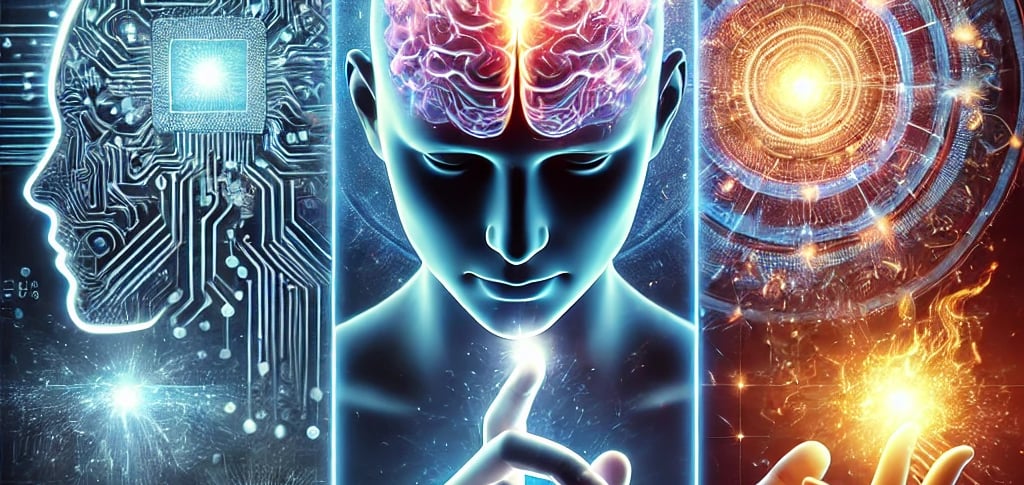AI, Cognition and Experience: Why Human Intelligence Remains Inimitable?
Artificial intelligence is rapidly gaining ground in Europe, from public services to businesses, but can it really replace human intelligence? Between machine learning, language and real-world experience, find out why AI models like ChatGPT and Perplexity remain fundamentally limited compared to human cognition.
COMMUNICATIONVEILLE SOCIALE
Lydie GOYENETCHE
2/7/20254 min read


ChatGPT vs Perplexity: Two AI engines versus human intelligence
The meteoric rise of artificial intelligence in public services and companies raises the question of how it works and its limits compared to human intelligence. Two emblematic tools of this evolution are ChatGPT and Perplexity AI. Although their purposes differ – the former being a conversational model and the latter an AI-augmented search engine – their design is based on common machine learning and machine learning principles.
Faced with these technological advances, it is becoming essential to question the nature of their intelligence and to confront it with human cognitive processes. Far from being equivalent, these forms of intelligence obey radically different logics. Through the theories of Jean Piaget and other cognitive psychologists, we will shed light on what profoundly distinguishes artificial learning from human development.
Artificial intelligence and human intelligence: opposing ways of working
AI works according to machine learning principles. ChatGPT and Perplexity AI are trained on massive volumes of textual data and use probabilistic models to generate or synthesize responses. ChatGPT, as a conversational model, predicts the most likely sequence of a sentence based on the billions of texts it has been trained on. Perplexity AI, on the other hand, combines a classic search engine with an advanced language model, allowing it to draw on verifiable sources and offer a structured synthesis of them.
However, these intelligences only process pre-existing data. They do not learn by interacting with their environment, do not actively test their hypotheses, and do not spontaneously adapt their understanding to new experiences. This fundamental characteristic contrasts them with human intelligence, which, according to Piaget, is built up gradually, through trial and error, over the course of the experience of reality.
Human learning is more than just accumulating data. It is based on an active process of exploration, interaction and transformation of cognitive patterns. From birth, the child experiences the world through touch, hearing and sight, gradually developing an understanding of his environment. As he grows, he adjusts his mental representations based on new experiences and interactions with others. This cognitive plasticity, which allows human intelligence to evolve continuously, is completely absent in AI.
Language: a construction embodied in the human experience
Another fundamental element distinguishes human intelligence from artificial intelligence is the way language develops. Unlike AI models, which treat words through a purely statistical prism, human language is directly linked to the experience of reality and social interactions.
According to Lev Vygotsky, language is not limited to a means of communication. It is a tool for structuring thought, shaped by exchanges with others and by individual experience. A word is not just a set of letters or sounds, it is loaded with meaning according to the history of the person who pronounces it. When a child learns a word like "fire", he does not just memorize its definition: he perceives its heat, light, danger. Its learning is sensory, emotional and contextual.
On the other hand, an AI never experiences the world. She perceives neither pain, nor joy, nor the implicit meaning of a sentence according to the tone or intention of the interlocutor. When it produces a text, it simply recombines words according to their most likely occurrences in a given context. This lack of lived experience limits her understanding and makes her unable to fully interpret the complexity of human language.
Let's take the concept of "mourning" as an example. An AI can provide a definition and synthesize testimonies, but it has never experienced it. She cannot grasp the inner pain that accompanies it, nor the infinite nuances of feelings that vary from one person to another. A human being, on the other hand, will understand this notion through their own experiences, emotions and interactions with those around them. This embodied dimension of human language is inaccessible to AI models, which remain locked into a purely formal processing of textual data.
The limits of AI in complex human situations
This essential difference between human intelligence and AI raises major questions about the use of these technologies in contexts where the human experience is paramount. In public services and companies, AI is increasingly used to automate complex tasks, particularly in recruitment, legal assistance or even psychological support.
However, an AI, even an advanced one, cannot really assess a human situation. In a professional conflict, for example, a model like ChatGPT can analyze emails and detect language tensions. But only a human manager will be able to understand the underlying emotions, interpret non-verbal language and adjust their approach according to the reactions of the individuals concerned. AI, in the absence of lived experience and subjectivity, can perceive neither the power dynamics, nor the unspoken, nor the real intentions of the protagonists.
This limitation is particularly glaring in the support of people in psychological distress. More and more AI tools are being used to provide emotional support, but they remain fundamentally disconnected from the reality of human suffering. A person who is bereaved or in a situation of distress needs an authentic exchange, where the interlocutor shares an emotional space with them. A computer program, no matter how sophisticated, cannot provide this essential human presence because it feels no true compassion or empathy.
A necessary complementarity, but an impossible substitution.
While artificial intelligence offers powerful tools for processing large amounts of information and automating specific tasks, it can in no way replace human intelligence. Where AI works on probabilistic models, humans rely on their experience, intuition and sensitivity. Where AI manipulates words without grasping their lived impact, humans give meaning to language according to its history and its relationship to reality.
The future of artificial intelligence therefore does not lie in a desire to replace humans, but rather in intelligent collaboration where AI remains a tool under the supervision of the human mind. Its effectiveness will depend on our ability to use it critically and responsibly, always keeping in mind its fundamental limitations.
True intelligence, beyond algorithms and statistics, remains the one that knows how to show discernment, reflection and humanity.


EUSKAL CONSEIL
0033782505766
euskalconseil@gmail.com
This website uses only Plausible Analytics, a privacy-friendly web analytics tool.
No cookies are used, and no personal data is collected from visitors.
The system is fully compliant with the General Data Protection Regulation (GDPR), the ePrivacy Directive, and CNIL recommendations.
You can read more about Plausible’s data policy here: https://plausible.io/data-policy